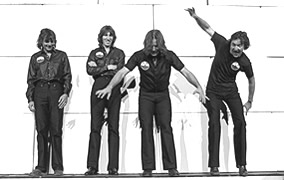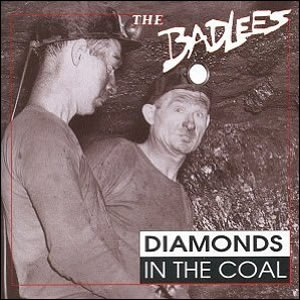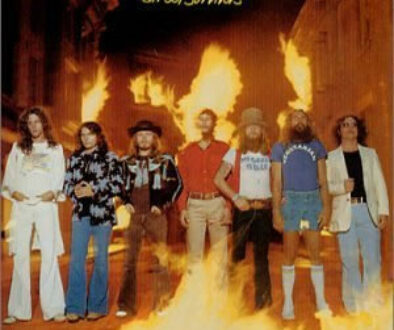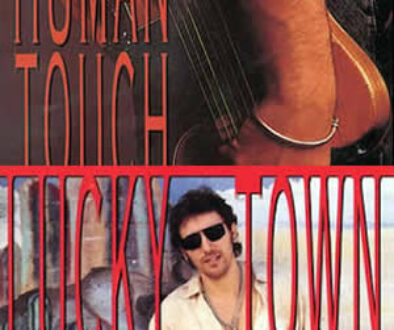The Wall by Pink Floyd
 The Wall was the most ambitious album of a long and storied career filled with ambitious projects by Pink Floyd. This double-length concept album was composed by vocalist and bassist Roger Waters and spawned an equally ambitious tour, a feature film, and a legacy which has only grown in the three and a half decades since its release in 1979. Today is the 25th anniversary of the fall of the Berlin Wall. In conjunction with The River of Rock, we celebrate this historical date by publishing this album review along with a review of the 1982 movie Pink Floyd The Wall on Big Blue Bullfrog and a review of the 1990 concert Roger Waters The Wall Live in Berlin on Kid’s Theatre News.
The Wall was the most ambitious album of a long and storied career filled with ambitious projects by Pink Floyd. This double-length concept album was composed by vocalist and bassist Roger Waters and spawned an equally ambitious tour, a feature film, and a legacy which has only grown in the three and a half decades since its release in 1979. Today is the 25th anniversary of the fall of the Berlin Wall. In conjunction with The River of Rock, we celebrate this historical date by publishing this album review along with a review of the 1982 movie Pink Floyd The Wall on Big Blue Bullfrog and a review of the 1990 concert Roger Waters The Wall Live in Berlin on Kid’s Theatre News.
The album’s concept was developed by Waters following Pink Floyds 1977 “In the Flesh” tour, which followed their previous studio album, Animals. With Pink Floyd at the height of their popularity on this tour, Waters became increasingly frustrated by the ever rowdier audience and began to imagine building a giant wall between the audience and the stage. Waters further developed the “Wall” idea to include isolation, problems with authority, and the real-life loss of his father as an infant during World War II. However, “Bricks in the Wall” (as it was then known) was not the only concept Waters developed at that time. A second concept album dealing with themes of marriage, sex, and family life was also presented to the rest of the band for a vote in 1978. Pink Floyd opted for The Wall, and the other concept would eventually be developed into Waters’ debut solo album, The Pros and Cons of Hitch Hiking in 1984.
The Wall has 26 songs which, by comparison, is the same number of tracks as Pink Floyd’s four previous studio albums combined. To help refine and produce this monumental project, Waters brought in Bob Ezrin, who had previously worked with Alice Cooper, Lou Reed and Peter Gabriel. Ezrin, Waters, and guitarist David Gilmour were the main refiners of the material, working from a 40-page script. The album was methodically recorded in several locations including England, France, and the United States. This was mainly due to the band’s year-long “tax exile”, which found them in odd living arrangements and often bickering with each other. Waters made it clear that he was in charge of the project, dictating the schedule and eventually advocated the firing of founding keyboardist Richard Wright when Wright refused to cut a family holiday short because Waters had moved up the recording schedule.
Drummer Nick Mason recorded many of his tracks independently at Britannia Row Studios in London early on in the process. This left Waters and Gilmour as essentially the only band members who fully participated in the day-to-day production through the end. When the team got to New York, Ezrin suggested that Michael Kamen and the New York Philharmonic and Symphony Orchestras, and a choir from the New York City Opera be recorded to enhance several of the theatrical tracks. Ezrin and Waters also captured many of the spoken-word and sound effects used on the album. The minimalist cover design and accompanying sleeve art was designed by cartoonist Gerald Scarfe, who later worked on the animation for The Wall tour and the 1982 film Pink Floyd The Wall, bringing a consistent feel to both projects.
 The Wall by Pink Floyd |
|
|---|---|
| Released: November 30, 1979 (Harvest/EMI) Produced by: Bob Ezrin, David Gilmour, James Guthrie Roger Waters Recorded: Britannia Row Studios, Studio Miraval, Correns, France, CBS 30th Street Studio, New York, Cherokee Studios, Los Angeles, July 1978-November 1979 |
|
| Side One | Side Two |
| In the Flesh? The Thin Ice Another Brick In the Wall, Part 1 The Happiest Days of Out Lives Another Brick In the Wall, Part 2 Mother |
Goodbye Blue Sky Empty Spaces Young Lust One of My Turns Don’t Leave Me Now Another Brick In the Wall, Part 3 Goodbye Cruel World |
| Side Three | Side Four |
| Hey You Is there Anybody Out There? Nobody Home Vera Bring the Boys Back Home Comfortably Numb |
The Show Must Go On In the Flesh Run Like Hell Waiting For the Worms Stop The Trial Outside the Wall |
| Group Musicians | |
| Roger Waters – Lead Vocals, Bass David Gilmour – Lead Vocals, Guitars, Mandolin Richard Wright – Keyboards Nick Mason – Drums, Percussion |
|
Later reprised on the final side, “In the Flesh?” is a reference to the band’s tour where the Wall’s initial concept began. For a few seconds the melody of the album’s last song “Outside the Wall” is played, solidifying the album’s comprehensive feel, before this track explodes into a riff-driven hard rock jam which immediately destroys the subtle stereotype brought on by previous Pink Floyd albums. The tracks single verse is in sharp contrast with gentle staccato piano and doo-wop harmony behind Waters’ lead vocals. After exploding back to the main riff for the coda, a dive-bomber effect crashes and is interrupted by the sound of a baby crying, symbolizing the protagonist’s loss of his father as a baby. “The Thin Ice” is much softer and measured, with Gilmour providing the verse vocals and Waters the chorus as, again, there is only one verse/chorus. Gilmour’s signature, slow bluesy guitar close out the song.
The three song medley; “Another Brick In the Wall, Part 1” / “The Happiest Days of Our Lives” / “Another Brick In the Wall, Part 2” is one of the most radio-friendly sequences of the album. Driven by Gilmour’s rhythmic guitar arpeggio, the segment eerily enters in contrast to the faint sound of children playing in the background. Waters melody is soft at through the first section as Gilmour adds overdubbed, sweet slide effects. After a helicopter effect, the second part is shorter with much more movement, vocal effects, and intensity, leading to group’s first and only number one hit, “Another Brick in the Wall, Part 2”. Although composed by Gilmour and Waters, it is Ezrin who deserves much of the credit for the song’s success, as he advocated for both the disco-flavored drum beat by Mason and the second verse and chorus, which featured a choir of schoolchildren. Like many of the early songs on the album, this was originally written as just one verse and one chorus and was barely a minute long. Without the band’s knowledge, Ezrin copied the first verse and spliced it in as an exact second. Inspired by his own earlier work on Alice Cooper’s School’s Out, Ezrin overdubbed 24 tracks of kids singing and laid it on top. The band was initially resistant to this, but eventually relented.
“Mother” is notable for variations between pure folk and differntly-timed waltz. Recorded later in the recording of the album, session drummer Jeff Porcaro was hired to lay down the beat under the guitar solo and later verse/chorus. Both Waters and Gilmour share lead vocal duties in this building song of question and answer dialogue between son and mother. Starting side two, “Goodbye Blue Sky” begins briefly as a pleasant folk song, which quickly turns dark with foreboding synths backing the picked acoustic guitar. “Empty Spaces” was an abridged, last second replacement for the longer “What Shall We Do Now?”, which did not appear until the Pink Floyd The Wall movie. Notable for its backwards-masked message, “Empty Spaces” acts as a bridge to the standard hard rocker “Young Lust”, a song about casual sex that has more Gilmour influence than any other on the album.
Starting with “One of My Turns”, the first half of the album concludes with four tracks that painfully describe the final internal steps of building the protagonist’s wall. “One of My Turns” is split into distinct segments, starting with a groupie’s monologue, followed by a soft ballad with Waters accompanied only by a synth-organ. Finally, the song snaps into a hard rock rendition of the protagonist’s violent breakdown, which terrifies the groupie. “Don’t Leave Me Now” uses some interesting sound and production techniques but has minimal lyrical content, while “Another Brick in the Wall, Part 3” is a much more rage-filled rendition of the earlier melody. Finally, this cross-fades into “Goodbye Cruel World”, a delicate song builds on Waters two-note bass riff and the slightest synth by Wright. The vocals are haunting and dry to end the first act of The Wall.
“Hey You” is an excellent song which uniquely sits just outside the album’s concept. In fact, this song, sounds like it may have fit in better on the previous Wish You Were Here or Animals albums. Starting with Gilmour’s crisp acoustic and smooth vocals, the mesmerizing ballad gains rock instrumentation on the way to the climatic guitar solo followed by the frantic last verse sung by Waters. The spooky “Is There Anybody Out There?”, starts with a horror movie like intro where the title is spoken several times in a well-treated voice. Then the song turns quite classical and sweet with an instrumental passage led by the classical guitar of session man Joe DiBlasi, backed by an orchestral arrangement. “Nobody Home” is a deep ballad that features Ezrin on piano behind Waters’ fine lyrical motifs. Two very short tracks follow which harken back to Britain during World War II. “Vera” directly references British singer Vera Lynn, who had a very popular song called “We’ll Meet Again” during the mid 1940s, while “Bring the Boys Back Home” is driven by military snare drums, a brass orchestra, and a deep choir accompanying Waters’ strained vocals.
 “Comfortably Numb” is one of the most indelible tracks on The Wall due to its pure theatrical sound and lyrical dialogue. Much like “Mother” earlier on the track, Waters and Gilmour vocalize separate characters through the contrasting verses and choruses. Gilmour composed the music as an instrumental during the recording of his self-titled debut album in 1978. Waters changed the key of the verse and added the lyrics and title. However, it wasn’t all happy cooperation as this song sparked a bitter internal fight over two distinct productions of the song. Waters wanted a more stripped-down version while Gilmour advocated for Ezrin’s grander orchestral version. In the end, they compromised with the lyrical areas keeping the orchestral arrangement and Gilmour’s closing guitar solo playing over the band’s rock backing.
“Comfortably Numb” is one of the most indelible tracks on The Wall due to its pure theatrical sound and lyrical dialogue. Much like “Mother” earlier on the track, Waters and Gilmour vocalize separate characters through the contrasting verses and choruses. Gilmour composed the music as an instrumental during the recording of his self-titled debut album in 1978. Waters changed the key of the verse and added the lyrics and title. However, it wasn’t all happy cooperation as this song sparked a bitter internal fight over two distinct productions of the song. Waters wanted a more stripped-down version while Gilmour advocated for Ezrin’s grander orchestral version. In the end, they compromised with the lyrical areas keeping the orchestral arrangement and Gilmour’s closing guitar solo playing over the band’s rock backing.
The fourth and final side of the original LP contains the most movement musically. The short linking track “The Show Must Go On” was to originally include The Beach Boys’ doing the backing vocals, but ultimately Bruce Johnston was the only member of that band to be recorded, along with a vocal ensemble that included Toni Tennile of The Captain and Tennile (these same backing vocalists were used for “Waiting For the Worms” later on side 4). “In the Flesh” is a reprise of the opening track which starts a violent sequence of songs where the story’s protagonist envisions himself as a fascist dictator and his concerts a political rally where “undesirables” are thrown “up against the wall” in an apparent Che Guevera-type execution method. On “Run Like Hell”, the violence spills out into the streets as told through Waters’ ever-strained, multi-tracked vocals. Musically, this upbeat piece is one of the most rewarding on the album, featuring Gilmour playing ostinato with rhythmic echoes, the only keyboard lead by Wright, and tactical effects and screams to frame the intended scenes.
“Waiting for the Worms” is less frantic but just as potent as its preceding track, with Gilmour and Waters alternating vocals and moods once again. Political and philosophical, this track straddles the lien between the internal strife of the protagonist and real-life commentary on the British empire itself. During the climatic outro, a crescendo is built until it crashes to a halts with “Stop”, where the hallucination ends and the protagonist resolves to settle his own mind once and for all. “The Trial” was composed by Waters and Ezrin and is unlike any song ever made by Pink Floyd. With Waters using several distinct voices to play the various characters. Most of the actual music is performed by the Kamen-conducted New York Symphony Orchestra in grandiose style, with a nice guiding piano by Wright and just a few splashes of traditional rock elements added by Gilmour and Mason. Ultimately, the judge renders his verdict and orders, “tear down the wall!” with a subsequent, repeated climatic chorus. “Outside the Wall” is a dénouement to the album, which takes place in the uncertain time after the wall has been torn down.
One of the best selling albums of 1980, The Wall had sold over 23 million by century’s end. It topped the charts in six different countries, including the United States, and reached the Top 10 in several more. Pink Floyd The Wall followed as a major motion picture in 1982. The band followed the album with a highly theatrical tour which included the building (and tearing down) of a 40-foot high wall of cardboard bricks on the stage. This would be the last Pink Floyd to include Waters (who left the band in 1983) and the recently-fired Wright was hired on as a paid touring musician for this tour. Ironically, he was the only musician to make money, as the other three absorbed financial losses due to the elaborate production. In 1990, Waters broke out this elaborate set for a single concert to celebrate the fall of the Berlin wall called The Wall – Live in Berlin.
~
Part of Classic Rock Review’s celebration of 1979 albums.





The Wall Live in Berlin by Roger Waters | Kids Theatre News, Central PA
November 9, 2014 @ 12:15 pm
[…] by Peggy Fay Albano is done in conjunction with The River of Rock, and is published in along with an album review of The Wall 1979 album on Classic Rock Review and of the 1982 Pink Floyd The Wall classic movie review on Big Blue […]
Pink Floyd The Wall movie review | Big Blue Bullfrog
November 9, 2014 @ 1:12 pm
[…] Today’s article is done in conjunction with The River of Rock, and is published in along with an album review of The Wall 1979 album on Classic Rock Review and of the 1990 Roger Waters The Wall Live in Berlin concert review on […]
Tear Down the Wall! | River of Rock
November 9, 2014 @ 2:27 pm
[…] Floyd The Wall 1979 album review on Classic Rock Review 1982 movie review on Big Blue Bullfrog 1990 concert review on Kids Theatre […]
May 15, 2017 @ 9:29 pm
The drummer’s name is Nick Mason.
May 16, 2017 @ 6:22 am
Thanks for pointing out the mistake, we’ve corrected.
May 16, 2017 @ 10:05 am
Roger Waters final album was The Final Cut in 1983
Pink Floyd The Wall
February 2, 2018 @ 9:32 am
[…] Today’s article is done in conjunction with The River of Rock, and is published in along with an album review of The Wall 1979 album on Classic Rock Review and of the 1990 Roger Waters The Wall Live in Berlin concert review on […]
The Making of The Wall by Pink Floyd, Podcast - Monster Shop: Iconic Albums
January 7, 2025 @ 9:05 am
[…] Classic Rock Review […]
Pink Floyd's The Wall: An Epic Rock Opera Explored - Riffology: Iconic Rock Albums
February 27, 2025 @ 1:01 pm
[…] Classic Rock Review […]